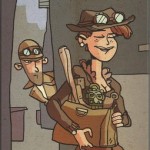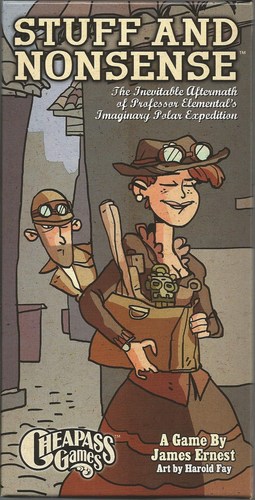 Stuff and Nonsense from Cheapass Games has the players pulling up a chair in London’s Adventurer’s Club to extoll the tales of their latest daring treks to foreign lands, and the no doubt heroic and interesting things that they did along the way. The only thing is, the adventures never really happened. In reality the players are running around all over London, hitting up various stores and locations to find facts and anecdotes, knick knacks and photographs that they can use as “proof” of their wild foreign antics.
Stuff and Nonsense from Cheapass Games has the players pulling up a chair in London’s Adventurer’s Club to extoll the tales of their latest daring treks to foreign lands, and the no doubt heroic and interesting things that they did along the way. The only thing is, the adventures never really happened. In reality the players are running around all over London, hitting up various stores and locations to find facts and anecdotes, knick knacks and photographs that they can use as “proof” of their wild foreign antics.
The only problem is, they got the idea from Professor Elemental, and he’s not super happy about them honing in on his territory.
Gameplay
Stuff and Nonsense plays out by having the players travel around on a “board” constructed of cards that represent the various locations around London where suitable proof of adventuring can be found. These cards are laid out in a circle around the Adventurer’s Club and the Market, creating a wheel and spoke lay out. Additional cards that represent the actual proof (in the form of Artifacts, Specimens, Facts, Anecdotes, Heroes, and Photographs) are dealt out in small numbers to the players, and eight of them are placed on the “board” at the appropriate locations based on their type. The players must then leave the Club and travel to the different locations (the Pub, News Stand, Junk Shop, etc.) to try to retrieve them.
Each player can move one space on the board each turn, either clockwise or counter-clockwise on the wheel, or back to either the Club or the Market in the center. If they land at the Club they must tell the story of an adventure, if they go to the market they discard a card and draw a new one at random from the draw pile. At any other location they will pick up one of the cards that is available there and add it to their hand.
Each of the cards has an amusing description of the item or story that it represents, and some art to show it off, but also contains a list of its relevance to each of the various adventure destinations available in the game. For example the Ragged Long Johns are great in a story about your trip to the South Pole, and are passable as proof of your journey to the top of Mt. Everest, but add no credence at all to your tale of adventure in the African jungles.
Once a player has enough evidence to spin a believable story they will return to the Club, lay out their tale (optionally by actually explaining their adventure to the other players), and reap the benefit of the adulation of their peers. Each adventure destination offers a different point reward and requires a different minimum amount of proof to pull off. There are also bonus points available for each adventure that vary depending on how hungry the people at the Club are for a given type of tale, or how often they’ve heard that one before.
For the adventurers it’s a nearly perfect plan, but there’s one kink. All of this was originally Professor Elemental’s idea, and he is so on to you. The good professor spends his time moving around the circle of the board, propelled whenever a story is told in the club, or sometimes when replacement cards are dealt after an adventure card is taken (each card has a number in the lower corner, if it’s higher than the number of players the Professor is on the prowl). If he catches the players they will have to either give up one of their items or take a hit and lose some of their points. His position on the board can quickly make a player change their plans as they have to decide if avoiding him is better than risking a key adventure card falling into the hands of one of their opponents.
The game has a target score laid out based on the number of players, and ends when that target is reached.
Components
The game consists of 100 standard sized cards, one six sided die, six player tokens, and one slightly larger token to represent Professor Elemental. The card art is consistent with the theme and the text is overall very entertaining, so reading through the cards as you explain your adventures is a lot of fun.
The concept of a board game with no board isn’t exactly new, but it’s played perfectly here, allowing the game to take up very little space on the shelf while still providing a viable board game experience, which is nice. The cards for the adventure locations also double as gauges, each of the five destination cards has a circle of points on them, turning the card into a new orientation changes the number of bonus points available for completing that adventure. All in all the design is very tight and well done.
Theme
The gameplay in this game does a fantastic job of really making you feel the theme and the story behind it. You are doing exactly what it says you are doing on the box: running around London, finding things to help you fake an adventure. The sense of distance is helped with the limited movement, and the differences in the locations is enforced by having the adventure cards grouped into the different types. Since only one card of each type can be used on an adventure the players really have to stay on the move, especially with the Professor hot on their tails.
The interactions with the Professor is another great reinforcement of the theme as well. If you think of the points that you earn as an indicator of how impressed people are by your adventures, then the penalty for running into the Professor really comes down to “Give me that valuable item or I’ll expose you as a fraud.” It works beautifully.
Beyond that, all of the adventure cards have a nice quick little story on them with a consistent humor that pair nicely with the overall concept of the game, and work well with Professor Elemental’s body of work so far. If that sentence confused or surprised you, yes, Professor Elemental is a real person, or at least a fictional persona performed by a real person. He’s a self proclaimed “Chap-hop” artist with a number of albums and videos out. See the youtube video for Fighting Trousers if you haven’t already, to get a feel for the kind of thing you’re in for.
Replay
The game is fun in and of itself, but gets a lot of the extra shine comes from the humor on the adventure cards. After several games with the same players the novelty of the strange vegetable, or the fact that noodles are yummy is likely to start to wear off, leaving you with just the fun of the basic mechanics. That will probably lessen the enjoyment of the game as a whole, but the basic mechanics are solid enough that it probably won’t prevent further plays.
Final Thoughts
Stuff and Nonsense is a tight little game with solid mechanics and good light gameplay that should stay engaging for a long time. The fun and well integrated theme on top of that is icing on the cake. All in all this little package game is a great go-to for casual players, while still providing enough depth and strategy to be engaging.

Stuff and Nonsense by James Ernest
Published by Cheapass Games
